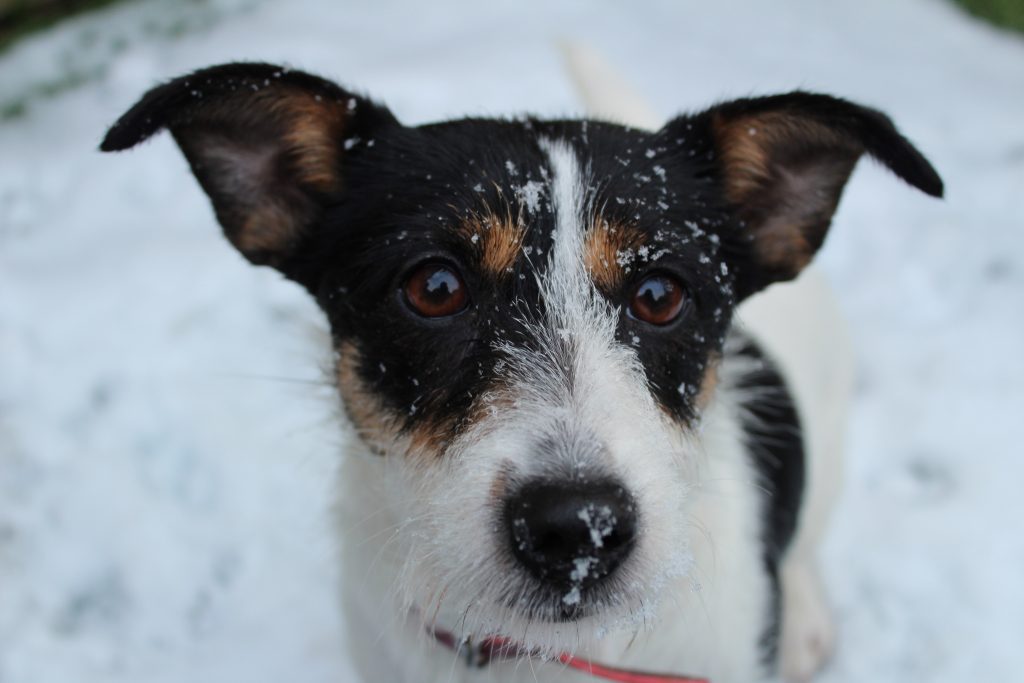
Winter can be a fun time of year for pets since there are a lot fewer insect and heat-related issues to contend with, and there is snow to eat and romp in over many northern and mountainous areas. However, the winter months hold their own cautionary tales and it’s just as important for pet owners to be aware of winter safety even though summer safety issues tend to make more headlines.
Just as pet owners make special arrangements for the summer months when temperatures climb into the 90’s and 100’s, so too must pet parents take precautions and make living adjustments for the winter months. It’s always a good practice to err on the side of caution and keep pets indoors during the winter, but with special preparations and housing, a long-haired dog breed that is bred and trained to endure cold weather such as a Siberian Husky, Alaska Malamute or a Saint Bernard can thrive in winter conditions as long as they aren’t left outside for long periods in below-freezing temperatures.
The following Winter Safety Tips for Pets is a good guide to follow for keeping pets safe over the winter months. These apply primarily to dogs and cats, but the principles apply to any type of pet that would normally be outside during some or much of the year.
Bring Pets Inside
Whenever possible, bring pets inside for the winter. Even for pets that normally spend much of the year outdoors, it’s advisable to bring them indoors during the winter months.
If that’s not possible and if a dog is long-haired, has a thick coat, has been bred for cold temperatures, and has been acclimated to the cold, then special housing that is raised and insulated can be an outdoor living option. Both food and a water supply that won’t freeze should be made readily available. Just be sure your pet isn’t exposed to prolonged periods when the temperature is below freezing. A properly sized dog house or enclosure allows for the pet to both sit up and lie down but is small enough to trap most of the body heat. The enclosure also needs to be dry, not susceptible to drafts, and the door protected with a flexible covering. In addition, the dog house or enclosure should face away from the north wind.
Bundle Up
If your pet is short-haired, consider getting him a pet jacket or sweater that will cover his coat from neck to tail and across the belly area. A pet coat can make all the difference between your pet being comfortable or not so comfortable. Pet coats come in all sizes, shapes, and colors, so there is one to match any look you are wanting.
Know Your Pet’s Limits
With most pet parents knowing their pet’s limits during the heat of the summer, so too should pet parents know their pet’s limitations in the wintertime. As with us, a pet’s cold tolerance can be dependent on the thickness of their coat, amount of body fat, health, and level of activity. Since our pets are covered in fur from head to toe, many enjoy cooler months more than warm months and become more energetic due to the cooler weather. However, during colder conditions, we may need to shorten walks to take into account possible hypothermia or frostbite to extremities. Short-haired pets can get cold much faster than long-haired pets and short-legged pets can come into more contact with snow and ice than taller pets. Pets with longer hair can typically stay out longer and won’t have to wear a coat in many instances.
Fuel Up
A lot of extra energy is burned up in the winter by pets trying to stay warm. Feeding your pet a little more food is not such a bad thing in the winter as it provides much-needed calories. Just make sure to exercise your pet as much as possible so they don’t become too overweight. Good hydration is also important in the winter because the air, both indoors and out, is typically dryer and more moisture is lost to the dry air than when it is humid. Ample hydration will also aid in keeping your pet’s skin more conditioned and not as dry.
Chemical Dangers
From salt and deicers that melt snow and ice on the streets and sidewalks to spilled or open containers of coolant/antifreeze, these are some of the chemicals to watch out for when pets are around. Paws can trap quite a few contaminants, so it’s best to wipe down your pet’s feet after a walk in the winter if chemicals are actively being used.
Be sure to keep chemicals put away and out of the reach of pets. It’s especially important to keep ethylene glycol antifreeze away from pets since it tastes sweet to animals and can quickly become deadly. Consider using products that contain propylene glycol instead. They are not pet-friendly in large quantities, but small amounts won’t typically cause harm. Before going for a walk on icy or treated surfaces, a paw protectant gel or booties can be used to ward off chemical exposure. Utilizing pet-friendly ice melting products can aid as well.
Skin Care
During cold, dry winter months, a pet’s skin can become drier, flakier, and more itchy than normal. Paws can become chapped, and the combination of dry, cold outdoor air and dry heat inside can lead to dry skin. To combat this, fewer baths should be given so the skin retains more of its essential oils and doesn’t become too dry. Keeping the inside humidifiers going will also help keep everyone’s skin moister. When a bath is given, a special moisturizing shampoo can be used to help with itchy skin.
Grooming
A pet should never be completely shaved during cold weather. It exposes too much skin and robs a pet of their natural protection from the cold. If a cut is needed, a trim is more appropriate so your pet can utilize their fur to their advantage during the time of year they need it most. Trimming the fur between the paw pads for dogs that have long hair will go a long way toward keeping ice balls from forming. It will also allow for better traction on the ice and snow and less cleaning of the paws after venturing outside.
Check your Vehicle
During cold days and nights, outdoor and feral cats often seek out warm places in which to escape the cold. Too often this includes vehicle wheel wells and engine compartments. Unless you want a cat to use up all of its nine lives as the feline did in the movie Christmas Vacation, then it’s good to tap on your hood or side of the vehicle and even honk the horn to wake up any unsuspecting cat. Another reason to check your vehicle is to make sure your pets are inside and haven’t been left in your car or truck. We have all heard horror stories about pets being left in a hot car during the summer, but in the winter a vehicle tends to hold the cold in like a refrigerator and animals can freeze to death.
Leash Up
Untold pets become lost during the winter months because ice and snow cover up normally recognizable scents that animals often use to find their way home. Walking pets on a leash will avoid this terrible scenario. If your pet has a collar with an identification tag and is microchipped, that will also aid in finding a lost pet if it becomes separated. Remember to keep the microchip information up to date with your veterinarian.
Avoid Ice

By avoiding icy patches and frozen ponds/lakes, your pet’s safety will be enhanced. It’s hard to know where ice begins and ends and it’s hard to determine if a pond or lake is frozen enough to support everyone’s weight. It’s best to just steer clear of any ice. While not ice, metal food and water bowls are also dangerous in the winter because a pet’s tongue can become stuck on the metal surface and could end up being a painful experience for both pet and owner when the tongue has to be removed from the frozen surface.
The above Winter Safety Tips for Pets provides a good point of reference, but there are undoubtedly additional safety tips that can be followed by pet owners to ensure the complete safety of pets during the winter chill. The main takeaway from this list should be that cold weather can be enjoyable if certain precautions are taken ahead of time. Winter is a magical time and to be able to enjoy this season with our furry friends is one of life’s special treats.
10.04.2021
It’s that time of year again when it becomes more noticeable that the days are getting shorter, the nights a little cooler, and leaves have started to change color. >>> READ MORE
 15 Ways Dogs Impact Our Lives More Than We Realize
15 Ways Dogs Impact Our Lives More Than We Realize
08.26.2021
Dogs impact our lives more than we realize. The list below is just the tip of the iceberg. There are even more ways in which pets, and dogs, in particular, impact our daily lives... >>> READ MORE

15 Most Essential Supplies for Cat Owners
07.28.2021
Cats are unique animals, and cat ownership can be a wonderful experience when properly prepared. Cats are often viewed as aloof, self-sufficient, and more independent than other pets, but there are still essential needs that cats have to maintain a healthy, engaged, and enjoyable life.... >>> READ MORE
 Dog vs. Cat Ownership - Which is right for You?
Dog vs. Cat Ownership - Which is right for You?
11.24.2021
Which kind of pet is right for you? While there are pros and cons for every species; there is typically a personality and lifestyle match for everyone... >>> READ MORE
How to Keep Your Cat Happy & Healthy
09.14.2020
As summer comes to an end, it’s the perfect time of year to start spending more time with our feline companions. And as it just so happens, ... >>> READ MORE
Please complete this form and click "Submit". Our Customer Support team will gladly address your request and respond in a timely manner.
Richell USA, Inc.
Copyright © Richell, Inc.. All rights reserved